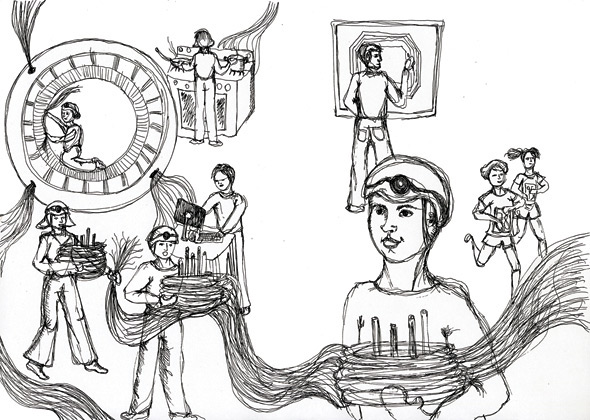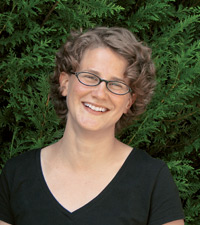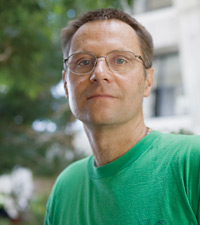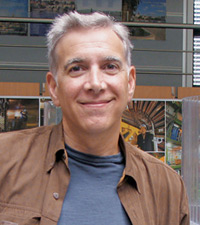Life at the LHC reaches fever pitch
As the big collider ramps up, four physicists talk about working late, finding time to play, and staying connected to family and friends.
By Katie McAlpine
 |
| Illustration: Sandbox Studio |
Alessandra Ciocios work on the Large Hadron Collider is both a passion and a sacrifice. In pursuit of this opportunity to open windows onto the unknown, revealing particles and phenomena no human has observed before, she sacrifices time with family and friends—not to mention time to relax.
But some things are too precious to give up.
Cooking is my therapy, she says, and sharing a meal at the dinner table is the most important part of the day. Early evening often finds one of her daughters sitting in the kitchen, getting some help with homework, while delicious aromas fill the room—pasta with zucchini (from Ciocios homeland, Italy), Californian avocado salad, or local crêpes with smoked salmon and crème fraîche.
Sometimes its hard. Sometimes one of us is late. But it all counts, Ciocio says. After catching up with her husband and daughters, shes likely to stay up until one in the morning sending emails and updating documentation for her part of the largest, most expensive experiment ever conducted.
Scientists like Ciocio have spent anywhere from a few summer months to the better part of their careers designing, building, installing, and testing parts of the Large Hadron Collider and the four major particle detectors stationed on its 27-kilometer ring, which straddles the Swiss-French border.
As the colliders superconducting magnets cooled and the underground detector caverns began to close, physicists worked long hours to ensure that the detectors will accurately measure the particles that shoot out from proton collisions—and to prepare for the avalanche of data to come.
Deep in the trenches
Most physicists would agree that their work is by turns frustrating and rewarding, but no one working on the LHC is deeper in the trenches than the graduate students and postdoctoral researchers. With no administrative duties, they split their time between putting together parts of detectors and writing software.
Martina Hurwitz, a graduate student at the University of Chicago, has been working on the ATLAS hadronic calorimeter since the summer of 2003. The calorimeter measures the energies of particles that contain quarks as they fly out of collisions.
At first she spent her days installing electronics on the calorimeter and connecting cables to test them, one segment at a time. She also helped to develop the software that turns the signal from the calorimeter into a physical quantity—in this case, the particles charge.
In fall 2006, anticipating data within a year, she switched to writing analysis programs to look for evidence of structure within quarks, which will be the subject of her thesis. However, delays in the completion of the LHC have kept her waiting another eight to 12 months.
I miss being more involved with the detector, Hurwitz admits. The thing that happens when youre working on the detector, though, is that it takes over all of your time.
While she waits, Hurwitz uses simulated data to explore the most effective ways to find quark substructure, and also builds and hones the software she will run on the data when it comes. This will make it easier to understand the data and extract the results she needs to write her thesis and finish her PhD.
Burning through a mound of simulated data often takes hours. To make good use of her time, Hurwitz occasionally starts running her software as shes cooking dinner, letting it run overnight and viewing her results in the morning.
For Hurwitz and many students like her, the delay in LHC start-up is putting off more than just interesting physics—its postponing their careers. Still, enthusiasm for science and sheer stubbornness keep her going. When she feels like shes treading water, leading tours of ATLAS helps renew her interest. I see other people get all excited about it, she says, and it really makes me happy about what were doing.
Hurwitz spends time hanging out with US LHC blogger Monica Dunford. Both are avid athletes, training for marathons and triathlons as well as shorter races. She also explores surrounding towns and hikes the Swiss mountains and forests with her American boyfriend, who is studying in Zurich. It worked out pretty well, she says, laughing.

The thing that happens when youre working on the detector is that it takes over all of your time. Martina Hurwitz Photo: Lisa McCarthy, CERN |
Work hard, play when you can
While the population of students and postdocs working on the LHC is considerable, plenty of physicists have been around since the beginning, helping to guide some component of one of the colossal detectors from design to installation and beyond.
Pawel de Barbaro, a Polish physicist employed at the University of Rochester, is among them. Hes been involved with the CMS hadron calorimeter for more than ten years.
He helped draw up initial plans for the detector and manufacture its rectangles of plastic scintillator— a material that emits light when a charged particle passes through. Coming to CERN fulltime in April 2003, he worked on layering the scintillator with brass plates from Spain, and led the installation of the detector segments in CMS.
Now, hes busy making sure the detector is reading signals from cosmic rays correctly. These high-energy particles, constantly raining down on Earth, are the nearest approximation to the particles that will fly out of proton collisions in the LHCs detectors.
To make certain that tasks get done on time, de Barbaro has stayed late and made many a weekend visit to the CMS site. Very often, if you just plan to start at nine and close up your shop at five, you come up empty handed, he explains. We have a functional detector. Thats the pleasure we get; thats the payback.
Outside CERN, de Barbaro is still not one to take much rest. My technique is, you can spend a lot of time at work, but the time you dont spend at work also you have to be active, he says. He visits the nearby Jura almost weekly, cross-country skiing when snow blankets the mountains and hiking or climbing when it doesnt.

We have a functional detector. Thats the pleasure we get; thats the payback. Pawel de Barbaro Photo: Reidar Hahn, Fermilab |
Cables, kids, and caffeine
Having a family draws time even tighter. Alessandra Ciocio makes a special effort to spend at least three hours with her two daughters in the evenings. Its easier in some ways, now that she and her husband Kevin, who is also a physicist, have moved the family to France.
As Ciocio describes dealing with an accident that broke her older daughters arm just before she was due to leave for a conference at CERN, her expression reflects the strain she had felt as a mother and physicist.
I had to postpone my coming here, but I was already scheduled to give a talk, she recounts. Luckily, she was able to see her daughter—ten years old at the time—through the period in the hospital and leave her in the care of a close family friend. She arrived in Geneva the day she was scheduled to speak.
She has spent the last 14 years working on ATLASs Semiconductor Tracker through Lawrence Berkeley National Laboratory. This silicon-strip detector will watch charged particles arcing through the powerful magnetic field of the solenoid, tracking their paths to within the width of a human hair.
As deputy commissioner for the tracker, Ciocio spent months in a hard hat and steel-toed safety shoes, laying miles of cable through the ATLAS pit. She followed each end of the wiring that will carry information to and from the tracker, making sure every one of the 9000 cables was connected according to plan.
Clearly there were nine very strong Russians who were pulling the cables, she says with a laugh; 300 feet of wire more than half an inch thick gets rather heavy.
During one intense period of wiring, Ciocio described her evenings as, I come out of the pit, pick [my daughters] up at school or at the bus stop, drop them off at their activity, go back in the pit And then having a 17-year-old who tells me, Oh, why are you so stressed out? I didnt imagine that driving was so stressful! Its not the driving!
Now that the wiring and tests are completed, her days increasingly fill with meetings and plans for the next round of tests. You need to constantly inform and discuss issues, problems, progress, planning, schedules, Ciocio says. Its all part of making progress.
She often finds herself working after her daughters go to sleep, sending e-mail and updating the internal wiki Web page. She doesnt go to bed until one or two in the morning, rising again at seven. Both her love for physics and cups of coffee keep her going each day. Although European coffee is widely regarded as better than American brew, she and her husband prefer the local Peets coffee of Berkeley, and they keep a supply at home in France.

I come out of the pit, pick [my daughters] up at school drop them off at their activity, go back in the pit Alessandra Ciocio Photo: Lisa McCarthy, CERN |
Working the 24/7 shift
After several years commuting to CERN every few months from the University of California, Santa Barbara, Joe Incandela moved there full-time in August last year with his wife and two sons. They rented a renovated mill in the French countryside and enrolled their children in French schools.
While the thick stone walls and waterfall flowing just outside their living room make for an idyllic setting, Incandelas responsibilities as deputy physics coordinator for CMS require a grueling pace. The scientists he works with are scattered around the world, and as a result are active around-the-clock.
I spend a lot of my time reading, he says. Reading tons of e-mail, planning documents, and physics takes up about two-thirds of his time; the rest he spends in meetings. He follows many of the 14 physics groups that meet every two weeks.
According to Incandela, The pressures been intense all along. Youre pressured by the schedule, but youre pressured already by the amount of activity. Theres so much information flowing that if you take time off, youre really almost unable to catch up.
He works at least one day each weekend, welcoming interruptions whenever his sons want him to join them for a game. The remaining day is set aside for a trip, such as skiing in the mountains, but I check email before and after, he says.
Hes amazed at how well his sons, Nathan and Joey, have acclimated to France: It helps to know that they are happy here. He makes sure to spend time with them on weeknights as well as weekends, but adds, When the boys go to bed, I work. Should he find himself awake at two a.m., hell catch up on what folks in the United States have been doing so he can hit the ground running the next morning.
Its a continuous struggle to keep up with all the activity, Incandela admits, but I recognize that Im in a very good position, with a view of all the physics that we are planning to do and knowing that what I do can help us prepare. Although it ties you down a fair amount, its good to stay on top of things because problems can arise that would otherwise erupt into bigger problems.
While work claims some time each day even when he is traveling on vacation with his family, he appreciates being in Europe and enjoys seeing the sights. Every time we have a break, we try to take the boys somewhere interesting, Incandela says. The list includes Paris, London, and Rome, but we usually just go to one of the wonderful places nearby, in France or Switzerland.

Every time we have a break, we try to take the boys somewhere interesting. Joe Incandela Photo: Lisa McCarthy, CERN |
Eyes on the prize
All four physicists say they enjoy helping bring the largest scientific endeavor to fruition.
We have a very large margin of freedom to choose what we want to do, and I think we choose things that are exciting to us, De Barbaro says. Not many professions offer this.
When the days start to feel long, or the details difficult and tedious, they turn their eyes back to the lofty purpose of the LHC.
We are trying to answer such fundamental questions—what constitutes matter and where it comes from, Hurwitz says.
I think that the excitement of being able to see something that no one has seen, trying to understand something as big as the universe its hard to beat, in terms of motivation, Incandela attests.
Its a passion, Ciocio says, a smile lighting her face. There have been many achievements along the way. The ultimate will be to really see collisions.
Click here to download the pdf version of this article.






